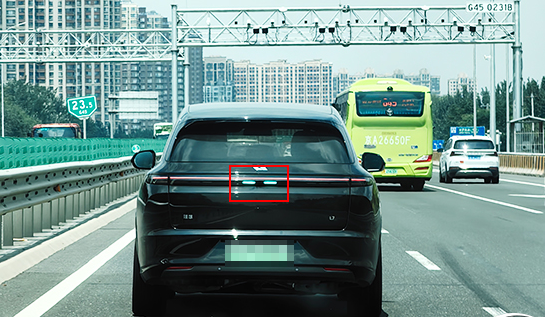In recent years, with the gradual popularization of assisted driving technology, while providing convenience for people's daily travel, it also brings some new safety hazards. Frequently reported traffic accidents have made the safety of assisted driving a hotly debated topic in public opinion. Among them, whether it is necessary to equip an assisted driving system sign light outside the car to clearly indicate the driving status of the vehicle has become the focus of attention.
What is the assistive driving system indicator light?


The so-called assisted driving system sign light refers to a special light installed on the outside of the vehicle. Through specific installation positions and colors, it is a clear indication to other vehicles and pedestrians on the road that the assisted driving system is controlling vehicle operation, enhancing road users' perception and interaction. It aims to improve road traffic safety and reduce traffic accidents caused by misjudgment of vehicle driving status.
Its working principle is based on the sensors and control systems inside the vehicle. When the vehicle turns on the assisted driving function, the system will automatically activate the sign lights to remind other road users to pay attention.
Led by car companies, assisted driving system sign lights are rarely used
At this stage, since there are no mandatory national standards, among the models on sale in the domestic automobile market, only Li Auto's models are actively equipped with assisted driving system sign lights, and the color of the lights is blue-green. Taking the Ideal L9 as an example, the entire car is equipped with a total of 5 marker lights, 4 at the front and 1 at the rear (the LI L7 has 2). This marker light is equipped on both the ideal AD Pro and AD Max models. It is understood that in the default state, when the vehicle turns on the assisted driving system, the sign light will automatically light up. It should be noted that this function can also be turned off manually.
From an international perspective, there are no relevant standards or specifications for assisted driving system sign lights in various countries, and most car companies take the initiative to assemble them. Take Mercedes-Benz as an example. After being approved to sell vehicles equipped with assisted driving mode (Drive Pilot) in California and Nevada, it took the lead in adding turquoise sign lights to the Mercedes-Benz S-Class and Mercedes-Benz EQS models. When the assisted driving mode is activated, , the lights will also be turned on at the same time to alert other vehicles and pedestrians on the road, as well as traffic law enforcement personnel.
It is not difficult to find that despite the rapid development of assisted driving technology around the world, there are still some deficiencies in relevant supporting standards. The vast majority of automobile companies focus on technology research and development and product marketing. For assisted driving system sign lights and other Insufficient attention is paid to key configurations related to road driving safety.
To improve road safety, it is imperative to install assisted driving system sign lights
In fact, the most fundamental reason for installing assisted driving system sign lights is to reduce the incidence of traffic accidents and improve road driving safety. From a technical point of view, although the current domestic assisted driving systems have not reached L3 level "conditional autonomous driving", they are very close in terms of actual functions. Some car companies have previously stated in their promotions that the assisted driving level of their new cars belongs to L2.99999... level, which is infinitely close to L3. Zhu Xichan, a professor at Tongji University School of Automotive, believes that installing assisted driving system sign lights is meaningful for intelligent connected cars. Now many vehicles claiming to be L2+ actually have L3 capabilities. Some drivers actually use In the process of using a car, L3 usage habits will be formed, such as driving without hands or feet for a long time, which will cause some safety risks. Therefore, when turning on the assisted driving system, there needs to be a clear reminder to other road users outside.

Earlier this year, a car owner turned on the assisted driving system while driving at high speed. As a result, when changing lanes, he mistook a billboard in front of him for an obstacle and then decelerated to a sudden stop, causing the vehicle behind him to be unable to avoid the car and causing a rear-end collision. Just imagine, if this car owner's vehicle is equipped with an assisted driving system sign light and turns it on by default, it will definitely give a clear reminder to the surrounding vehicles: I have turned on the assisted driving system. Drivers of other vehicles will be alert after receiving the prompt and take the initiative to stay away or maintain a greater safe distance, which may prevent the accident from happening. In this regard, Zhang Yue, senior vice president of Careers Consulting, believes that it is necessary to install external sign lights on vehicles with driving assistance functions. At present, the penetration rate of vehicles equipped with L2+ assisted driving systems is constantly increasing. There is a high chance of encountering a vehicle with L2+ systems on while driving on the road, but it is impossible to judge from the outside. If there is a sign light outside, other vehicles on the road will clearly understand the driving status of the vehicle, which will arouse alertness, pay more attention when following or merging, and maintain a reasonable safe distance.
In fact, similar warning methods are not uncommon. The most well-known one is probably the “internship mark”. According to the requirements of the "Regulations on the Application and Use of Motor Vehicle Driving Licenses", the 12 months after a motor vehicle driver obtains a driver's license is the internship period. During this period, when driving a motor vehicle, a uniform style "internship sign" should be pasted or hung on the rear of the vehicle body. ". I believe that most drivers with driving experience feel the same way. Whenever they encounter a vehicle with an "internship sign" on the rear windshield, it means that the driver is a "novice", so they will generally stay away from such vehicles, or follow or merge with other vehicles. Leave enough safety distance when overtaking. The same is true for assisted driving systems. A car is a closed space. If there are no obvious prompts outside the car, other vehicles and pedestrians cannot clearly judge whether the vehicle is driven by a human or by an assisted driving system, which can easily lead to negligence and misjudgment. , thereby increasing the risk of traffic accidents.
Standards need to be improved. Assisted driving system sign lights should be legally enforceable.
So, since the assisted driving system sign lights are so important, does the country have relevant policies and regulations to supervise them? In fact, at this stage, only the local regulations issued by Shenzhen, the "Shenzhen Special Economic Zone Intelligent Connected Vehicle Management Regulations" have clear requirements for the configuration of sign lights, stipulating that "in the case of autonomous driving, cars with autonomous driving mode should be equipped with automatic "External driving mode indicator light as a reminder", but this regulation only applies to three types of intelligent connected cars: conditional autonomous driving, highly autonomous driving and fully autonomous driving. In other words, it is only valid for L3 and above models. . In addition, in September 2021, the Ministry of Industry and Information Technology released the "Optical Signaling Devices and Systems for Automobiles and Trailers" (Draft for Comments). As a national mandatory standard, it added requirements for "autonomous driving sign lights" and the planned implementation date is July 2025. January 1st. However, this national mandatory standard also targets L3 and above models.
It is undeniable that the development of L3 level autonomous driving has begun to accelerate, but at this stage, the mainstream domestic assisted driving systems are still concentrated at the L2 or L2+ level. According to data from the Passenger Car Association, from January to February 2024, the installation rate of new energy passenger vehicles with L2 and above assisted driving functions reached 62.5%, of which L2 still accounts for a large proportion. Lu Fang, CEO of Lantu Auto, previously stated at the Summer Davos Forum in June that “it is expected that L2-level assisted driving will be widely popularized within three to five years.” It can be seen that L2 and L2+ vehicles will still be the main body of the market for a long time to come. Therefore, we call on the relevant national departments to fully consider the actual market conditions when formulating relevant standards, include the assisted driving system sign lights in the national mandatory standards, and at the same time unify the number, light color, position, priority, etc. of the sign lights. To protect road driving safety.
In addition, we also call on the Ministry of Industry and Information Technology to include in the "Administrative Measures for Access Licensing of Road Motor Vehicle Manufacturers and Products" to list the equipment with assistive driving system sign lights as a condition for new vehicle admission and as one of the safety testing items that must be passed before the vehicle is put on the market. .
The positive meaning behind driver assistance system sign lights
As one of the safety configurations of vehicles, the introduction of assisted driving system sign lights can promote the overall standardized development of assisted driving technology through the formulation of a series of technical specifications and standards. For example, through the design of the color and flashing mode of the sign lights, different levels of assisted driving systems can be further distinguished, such as L2, L3, etc., thereby accelerating the popularization of assisted driving systems.
For consumers, the popularization of assisted driving system sign lights will enhance the transparency of the entire intelligent connected car industry, allowing consumers to intuitively understand which vehicles are equipped with assisted driving systems, and enhance their awareness and understanding of assisted driving systems. Understand, promote trust and acceptance. For car companies, assisted driving system sign lights are undoubtedly an intuitive reflection of product leadership. For example, when consumers see a vehicle equipped with assisted driving system sign lights, they will naturally associate it with high technology and safety. Positive images such as sex are associated with each other, thereby increasing purchase intention.
In addition, from a macro level, with the global development of intelligent connected vehicle technology, international technical exchanges and cooperation have become increasingly frequent. Judging from the current situation, countries around the world do not have clear regulations and unified standards for assisted driving system sign lights. As an important participant in the field of intelligent connected vehicle technology, my country can lead and promote the standardization process of assisted driving technology globally by taking the lead in formulating strict standards for assistive driving system sign lights, which will help further enhance my country's role in the international standardization system status.
Post time: Aug-05-2024


